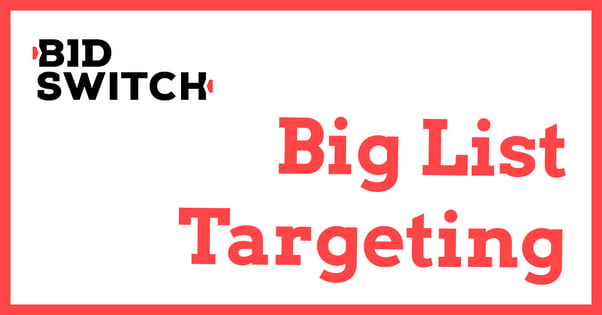With Big List Targeting on BidSwitch, demand partners can refine targeting with traffic filtering which allows them to zero-in on millions of potential users. In this article, we go in-depth on Big List Targeting and how it might help your campaigns.
What is Big List Targeting?
Big List Targeting for BidSwitch is a new feature that allows demand-side partners to filter the traffic they listen to based on larger lists of records than is currently possible in the BidSwitch platform or via API. These records represent targetable fields within bid requests, such as UUID, geo, device type, and other criteria partners may want to tap into in the bidstream.
BidSwitch currently has a maximum targeting list limit of 5000 records (or rows of data), but with Big List Targeting, you can target potentially millions of records. The only limitation is a maximum cloud storage capacity of 500mb – though this is more than enough space to upload several lists containing over a million records each.
Big List Targeting is applied at the T-Group level, and can support list exclusion or inclusion rules to further refine your traffic filtering.
How is Big List Targeting different?
Big List Targeting is different from what’s currently available currently in the BidSwitch platform and via API in two important ways:
- Big List Targeting supports traffic filtering based on lists much larger in size than what’s available in the user interface, which is currently limited to 5000 entries maximum.
- Big List Targeting requires you to upload files to a separate Google Cloud Storage bucket, which the BidSwitch engineering team can assist with setup.
Which traffic types can be filtered with Big List Targeting?
With Big List Targeting, you’re able to filter the following types of traffic at the moment:
- UUIDs (user.id field for website traffic, or device.ifa field for in-app)
- App bundles (app.bundle field)
- Domains (site.domain field)
With future updates, we’re planning to add support for IP address and EIDS field targeting, so please keep an eye out for our email newsletter or product update blog posts for details.
How to get started with Big List Targeting on BidSwitch
Big List Targeting uses Google Cloud storage buckets in order to host targeting lists up to 500mb, which is enough to store multiple lists including millions of records each. Once an account has been created, the BidSwitch team will configure a bucket and grant access to the service account you provide. If you’re unsure about how to do this, please reach out to your BidSwitch account manager.
Once your storage bucket is fully configured, you will be able to start uploading lists and applying those lists to T-Groups. By default, Big List Targeting updates lists from your storage bucket every 20 minutes.
How to make changes to Big Lists
To update an existing list currently being used in one or more T-Groups, you can change it by uploading a new list with the same file name to your cloud bucket. This will overwrite the existing contents for that list in the bucket.
Want to get started with Big List Targeting on your BidSwitch account today? Just reach out to your account manager and we’ll take it from there.

